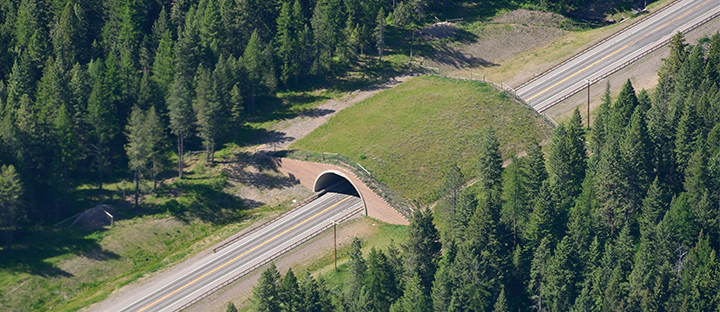Last week the U.S. Department of Transportation’s Federal Highway Administration (FHWA) announced $110 million in grants for 19 wildlife crossing projects in 17 states, including four Indian Tribes. The funding is made possible by a new program in the Bipartisan Infrastructure Law (BIL) and can support projects that construct wildlife crossings over and below busy roads, add fencing, acquire tracking and mapping tools, and more. Overall, BIL makes a total of $350 million available over five years under the Wildlife Crossings Pilot Program.
Each year, it is estimated that there are more than one million wildlife vehicle collisions in the U.S. Wildlife-vehicle collisions involving large animals result in injuries to drivers and their passengers, representing approximately 200 human fatalities and 26,000 injuries to drivers and their passengers each year. These collisions also cost the public more than $10 billion annually. This includes economic costs caused by wildlife crashes, such as loss of income, medical costs, property damage, and more.
“We are pleased to announce the first round of grants under the Wildlife Crossings Pilot Program to projects that will significantly reduce the number of collisions between motorists and wildlife,” said Federal Highway Administrator Shailen Bhatt. “These roadway safety investments will ensure that motorists and wildlife get to their destinations safely and are a win-win for safety and the environment.”
Project selections in this round of grants include:
* The Wyoming Department of Transportation will receive $24.4 million to build an overpass, several underpasses, and high-barrier wildlife fencing along 30 miles of US 189 in southwest Wyoming, a rural highway corridor with a high number of wildlife-vehicle collisions.
* The Colorado Department of Transportation will receive $22 million to build a dedicated overpass on I-25 between Denver and Colorado Springs, the state’s two most populous cities. Once completed, the Greenland Wildlife Overpass will be one of the largest overpass structures in North America, spanning six lanes of interstate highway. It will help reduce vehicle collisions with elk and mule deer along I-25 and connect vital habitats on both sides of the highway from the Great Plains to the Rocky Mountains.
* The Montana Department of Transportation (MDT) will receive $424,242 to complete a feasibility study for installing wildlife crossings across 68 miles on I-90 between Missoula and Garrison, Montana. By identifying key wildlife migration corridors, the study will help MDT determine the need, type, and feasibility of constructing one or more wildlife crossings that will effectively accommodate both wildlife and motorists, and ultimately reduce the number of WVCs.
* The Confederated Salish and Kootenai Tribes will receive $8.6 million to construct a wildlife overpass spanning US Highway 93 within the Ninepipe National Wildlife Management Area in Montana, an area with high rates of WVCs. The proposed project will help reduce WVCs and improve habitat connectivity for grizzly bears which will reduce crash-related mortality and improve outcomes for grizzly bears.
The Wildlife Crossings Pilot Program supports the Department of Transportation’s National Roadway Safety Strategy (NRSS), which sets a goal of achieving zero roadway deaths and serious injuries through a Safe System Approach to prevent crashes from happening in the first place. Projects funded by this program reduce wildlife crashes, which will reduce the associated economic impact (such as loss of income, medical costs, property damage, and decline in productivity and quality of life) while simultaneously improving habitat connectivity to sustain the environment and improve the overall safety of the traveling public.
The full list of project selections can be found here.
Jeff
HikinginGlacier.com
TetonHikingTrails.com
RockyMountainHikingTrails.com
Ramble On (2nd edition book on the rich history of hiking)
Exploring Glacier National Park
Exploring Grand Teton National Park


No comments:
Post a Comment